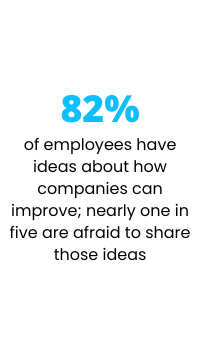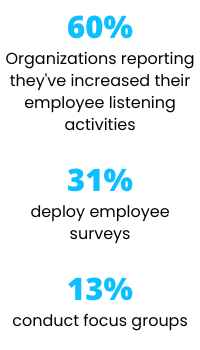Are You Listening to Your Employees?

Employee Listening Strategies Positively Impact Results


Employee listening strategies have become critical tools as organizations seek ways to effectively meet the challenges of doing business in a world that has changed individuals and companies, alike, over the past two years.
“Listening to employees can have a massive impact on business performance and workforce engagement, but it needs to be done right,” says human capital thought leader Josh Bersin.¹ “Listen frequently, understand what’s behind the numbers, and take action quickly and decisively.”
Listening Matters for Many Reasons


Many senior leaders are continuing to search for ways to optimize organizational operations within the context of a hybrid (remote and on-site) business model. As employers, they must listen to and respond constructively to workers’ demands for increased flexibility, whether that means remote versus on-site work options or greater choice in hours-per-day, days-per-week, shifts, or other decisions about the timing of work.
Finding and retaining the talent that organizations need to sustain business operations and drive growth is another top concern for company leaders at present. Latest figures from the U.S. Bureau of Labor Statistics confirmed that February 2022 ended with 11.3 job openings and little change in total employee separations (6.1 million).² Not surprisingly, nearly three-quarters of surveyed CEOs list labor shortages as the external issue most likely to disrupt their businesses.³
Because talent remains more difficult to find and more challenging to keep, employers are striving to provide differentiating and compelling employee experiences. Purposefully listening to employees (as well as potential job candidates) offers invaluable insights leaders can use to shape those experiences and an employee value proposition (what employees can expect to receive in return for the value they contribute) that supports better talent retention while also helping to ensure a healthy pipeline of interested applicants.
Even when organizations are not responding to the competitive talent market, other factors make employee listening a wise investment of time and effort. More than ever, companies look to Human Resources to be a strategic people-focused function. Insight into employee sentiment, ideas, and preferences is crucial to that heightened HR mission.
Further, progressive companies seeking to innovate effective new ways of working are tapping their workforces for creative input. A UK study found that 82% of employees have ideas about how companies can improve, but nearly one in five (18%) are afraid to speak up.⁴
How Employers Listen to Their Workers


Source: Willis Towers Watson
Employee sentiment surveys, also known as employee engagement surveys, are among the most popular tools organizations deploy to listen to their employees. Traditionally, these were administered once a year, but as the pace of change has accelerated, savvy talent leaders have reduced the size of their employee surveys but increased their frequency of deployment to keep a steadier finger on the pulse of employee sentiment.
Some employers administer smaller pulse surveys on a quarterly (or more frequent) basis. These may be stand-alone polls or used to supplement listening between deployments of larger, more formal surveys. While the temptation to sample employee opinion more often is understandable, companies must also weigh the risk of causing survey fatigue, which can reduce response rates and dilute the quality of results.
Another listening option is focus groups. These in-person or virtual discussions with small groups of employees enable a two-way flow of communication to elicit qualitative feedback. Facilitators may gain additional insights by observing which topics generate particular energy from group members.
Stay interviews are designed to enhance employee engagement and retention through interactions with valued current employees. These opposites of exit interviews seek information about what engages employees, motivates them to remain with the employer, and interests them as career-growth options. Stay interviews also aim to elicit information to optimize the employee experience by seeking input on improvements the employer could make.
Managers can serve as excellent conduits for employee listening, taking advantage of formal or informal one-on-one conversations to ask pertinent questions. Because informal opportunities may arise at any time, leveraging managers’ abilities to seek desired employee input requires purposeful preparation and managers’ active participation in listening strategies.
There are other means of listening to employees and gaining insights into their thinking, and a couple stand out. So-called continuous listening uses multiple mechanisms (surveys, interviews, etc.) to capture feedback at critical moments in the employee lifecycle (applicant experiences, on-boarding, career advancements, employee departures, etc.). Further, listening can be facilitated by scraping external websites, such as Glassdoor, that gather data from employees independently.
Starting an Employee Listening Survey
Obviously, there are many ways employers can listen to their workforces. A successful listening strategy requires an integrated (coordinated and multi-faceted) and planned approach. It also requires that an organization will act on the information obtained and communicate (and otherwise make visible) those actions to employees.
These are key questions to consider:


- Are organizational leaders committed to listening to employee voices?
- Does the company culture support a listening strategy? If not, what changes are needed?
- Who (or what business function) will be responsible for employee listening?
- What are the organization’s objectives in establishing a listening strategy? What business goals will be supported?
- How will listening be accomplished? An integrated approach requires multiple mechanisms (and teams to design and execute them). How often will methods be deployed and to whom (all employees, select groups, etc.)?
- What data be captured and how? Who will analyze it? Who will have access to the data and how will it be used?
- What processes will be required to ensure that appropriate action is taken in response to identified issues and how will that action be communicated?
- How will intelligence gained from employee listening be used to inform the employee value proposition, employee experience, and other relevant talent programming?
- Is there a schedule for regularly reviewing, revising, updating, and evolving the listening strategy and its components?
Your organization may have the internal resources and know-how to design and execute an employee listening strategy. If not, assistance is readily available from many outside vendors that specialize in employee engagement surveys or employee experience, human resource, and talent management consultation.
Related Training Programs
Media Partners provides proven manager training in many key areas. Below are trailers from a few or our most popular programs. Sign up to see full previews (it's free, quick and easy).
Learn more about Media Partners Manager and Supervisor training.









